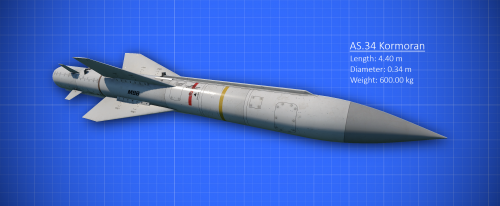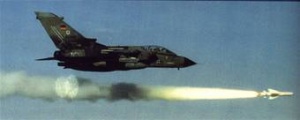Difference between revisions of "AS.34 Kormoran"
Colok76286 (talk | contribs) (Undo revision 169652 by U125033092 (talk)) |
Colok76286 (talk | contribs) (→See also: Edits) |
||
| (2 intermediate revisions by one other user not shown) | |||
| Line 98: | Line 98: | ||
;Other anti-ship missiles | ;Other anti-ship missiles | ||
| − | + | * [[AJ.168]] | |
| − | * [[ | ||
== External links == | == External links == | ||
Latest revision as of 17:54, 24 March 2024
Contents
Description
The AS.34 Kormoran is a German anti-ship missile. It was introduced in Update "Apex Predators".
Vehicles equipped with this weapon
General info
The AS.34 Kormoran is a German-designed and -produced anti-ship missile, which was primarily designed to target and destroy enemy ships and other water-borne targets, though it also comes with limited ground-attack capability. It was designed to be carried by the F-104G Starfighter and Tornado IDS Marineflieger aircraft (though in-game currently only on the Tornado).
The missile is designed as a fire-and-forget missile, which relies on an inertial navigation system (INS) in the initial phase directly after launch and active radar-homing (ARH) in the terminal phase. This means that in a real-world scenario, the pilot selects an acquired target on radar or visually points the missile at the intended target, after which the missile is launched and then autonomously guides itself onto the target.
The missile has a complex semi-armour piercing high-explosive warhead with a main charge and 16 additional shaped charges. The missile is designed to penetrate several bulkheads of a ship just above the waterline and then explode deep inside the ship for maximum damage in all directions.
| Missile characteristics | |
|---|---|
| Mass | 600 kg |
| Guidance | ARH+IOG |
| Signal | Pulse |
| Lock range | 50 km |
| Launch range | 32 km |
| Maximum speed | 0.9 M |
| Missile guidance time | 101 secs |
| Explosive type | Composition B |
| Explosive mass | 56 kg |
| TNT equivalent | 73.36 kg |
| Warhead type | SAP-HE |
| Armour penetration | 75 mm |
Effective damage
While possessing armour-piercing capabilities the missile truly does its damage through pure high explosive power. With 73.36 kg of TNTeq explosive force, the missile is more than capable of taking out lightly-armoured vehicles even with a hit to the ground close to the vehicle, as well as taking out better-armoured vehicles with a direct hit.
Comparison with analogues
Give a comparative description of missiles that have firepower equal to this weapon.
Usage in battles
Describe situations when you would utilise this missile in-game (vehicle, pillbox, base, etc.)
Pros and cons
Pros:
- Stand-off anti-ship missile provides capability to attack without risk of accurate return fire
Cons:
- Multiple missile attacks may be required to sink targeted ship
- Missile is rather slow, allowing targeted ship to perform maneuvers to dodge the missile
- During a side-on attack, the missile's top-down attack trajectory means it can hit the top of the targeted ship's funnels first, minimizing the amount of damage it can inflict and potentially spoiling a shot
History
The AS.34 Kormoran was the first major post-war missile project in West Germany.[1] It was designed to meet the needs of the West German navy for a large anti-ship missile for use in coastal waters.[2] Development began in 1962 and was handed over to West German aerospace manufacturer Messerschmitt-Bölkow-Blohm (MBB) in 1967. It wouldn't be until 1973 before the West German government decided to actually procure the missile and, after completing its trials in 1974, it finally entered into service with the West German Navy in 1977.[3]
The missile was originally based on a design by French Nord-Aviation, the makers of the AS-20 Nord, AS-30 Nord and AS-30L Nord missiles, using the inertial guidance system from their cancelled AS.33 missile project.[4] After taking over the project, MBB replaced the inertial guidance system with a new and more advanced missile guidance package. The missile body is very similar to the aforementioned missiles made by Nord-Aviation, with a 4.40 m long fuselage, a narrow cross-section of 0.34 m, and a sharp-pointed conical nose. On the sides of the fuselage sit four swept delta fins, just behind of the centre of the missile body, and a set of four smaller trapezoidal stabilizer fins between the delta fins and the tail.[3]
The missile guidance system is made up of an SFENA/Bodenseewerk inertial navigation system (INS), a TRT radio altimeter as well as a Thomson-CSF two-axis radar seeker. The propulsion system consists of two Prades solid rocket boosters and a central Eole IV solid rocket sustainer motor. Immediately after launch, the rocket boosters fire for 1 second before the sustainer motor fires and sustains flight for an additional 100 seconds before shutting off, allowing the missile a cruising speed of Mach 0.9 and an effective range of 23 km.[1]
The warhead is a complex delayed-fuse high-explosive fragmentation (HE-FRAG) munition, that is designed to be able to penetrate a total of 90 mm of armour, typically the hull plates of a ship, before exploding deep inside the target. The warhead weighs 165 kg and consists of 16 elliptical charges mounted radially in two rows, which project zirconium fragments at sufficient speeds for them to penetrate up to seven bulkheads inside the ship and cause severe damage to ammunition stores and critical systems.[1][3][5][6]
The missile is designed to be used against larger surface vessels, which allows the attacking aircraft to acquire the target, launch the missile and fly to safety before the target vessel is able to target and shoot it down.[6] Once the missile is launched, the INS and radio altimeter guide the missile to descend to a typical cruising altitude of less than 30 m and make its way toward the target vessel's last known position. Upon final approach, the radar seeker head searches for the target and locks on before descending to around wavetop height, guiding the missile to the current position of the ship and aiming to strike the ship just above the waterline.[1]
The missile is able to be fired by any combat aircraft that has target acquisition radar, a self-contained navigation system, and which is capable of maintaining speeds of a minimum of Mach 0.6 during launch.[6] Despite a previously aggressive marketing campaign by MBB, to date only Germany and Italy have purchased the missile.[3] The first aircraft to be equipped to carry and launch the AS.34 Kormoran was the now-retired F-104G Starfighters of the Marineflieger, the air wing of the West German navy. Later also the Tornado IDS of the German Marineflieger and Italian Aeronautica Militare were equipped with the missile and remain the only aircraft able to carry it to this day.[3]
The missile has never been used in a live combat situation but remains in storage with the German and Italian air forces for use with their remaining fleets of Tornado IDS aircraft. While the AS.34 Kormoran, and its later upgrade the AS.34 Kormoran 2, are still capable missiles in their own right, the changes in naval warfare with the advent of modern close-in weapon systems (CIWS) and ability to defeat attacking aircraft at long range, have made the missiles largely obsolete due to their fairly limited range.[3]
Media
- Videos
See also
- Other anti-ship missiles
External links
References
- ↑ 1.0 1.1 1.2 1.3 An Illustrated Guide to Modern Airborne Missiles, Bill Gunston, 1983.
- ↑ https://web.archive.org/web/20070813022441/http://www.missilethreat.com/cruise/id.12/cruise_detail.asp
- ↑ 3.0 3.1 3.2 3.3 3.4 3.5 http://www.military-today.com/missiles/kormoran.htm
- ↑ Jane's Strategic Weapons Systems, September 1997, JSWS-Issue 25
- ↑ https://patents.google.com/patent/DE3701390A1/en
- ↑ 6.0 6.1 6.2 https://www.usni.org/magazines/proceedings/1977/august/weapon-systems





